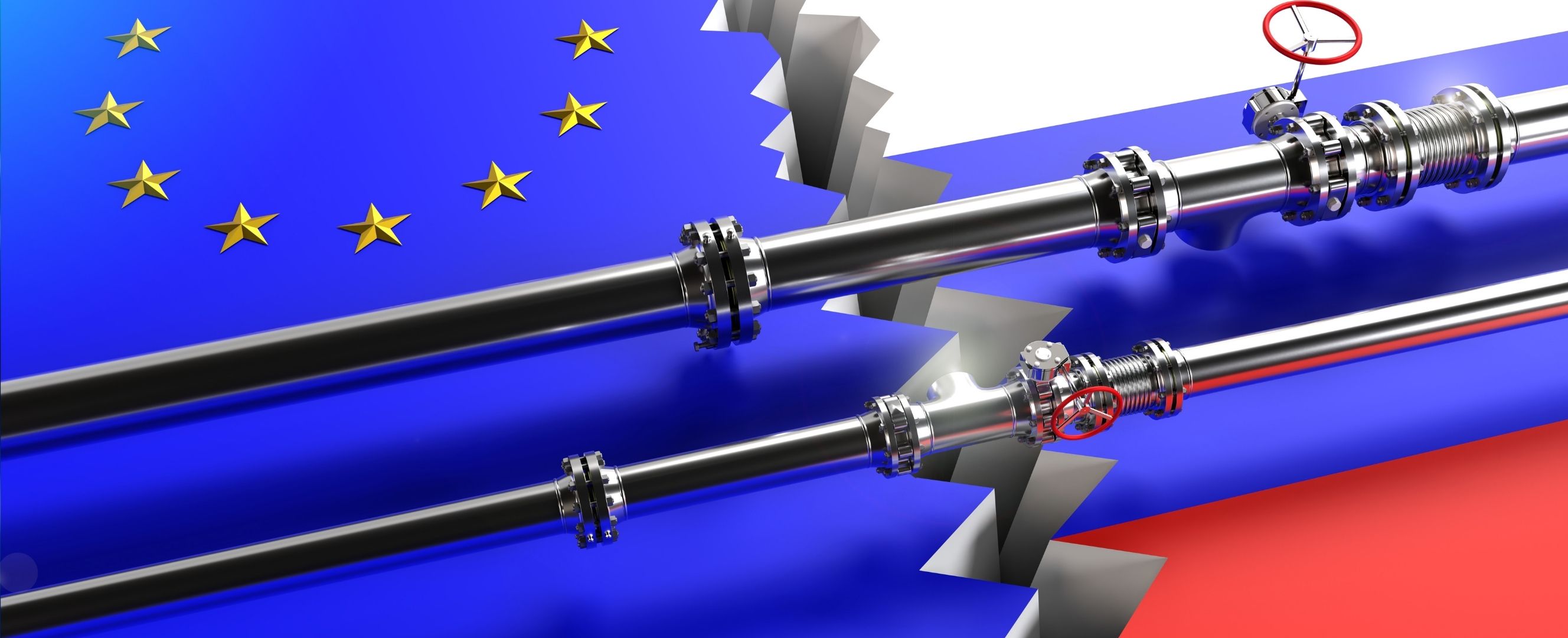The EU needs a grand bargain that reduces demand, increases supply, and keeps energy markets open
Europe’s energy system faces an unprecedented crisis. Supplies of Russian gas—critical for heating, industrial processes, and power—have been cut by more than 80 percent this year. Wholesale prices of electricity and gas have surged as much as 15-fold since early 2021, with severe effects for households and businesses. The problem could well worsen. Europe may be about to experience its first winter without Russian gas, risking even higher prices, gas shortages, and a major recession.
European governments have started to implement a range of policy responses. One class of policies aims to mitigate the impact of higher costs on consumers and businesses. These include retail price caps, regulated tariffs, support programs for energy-intensive companies, and liquidity or capital backing for energy companies, including even nationalization. Another class of measures seeks to stabilize and reduce wholesale prices and ensure energy security. This includes policies to encourage energy savings and increase supply but also to cap energy costs, particularly wholesale gas prices.
Such measures don’t offer clean solutions, for two reasons. First, conflicting objectives: subsidies or capping prices can make the underlying problem worse by increasing demand. Second, cross-border spillovers: subsidizing energy consumption may benefit consumers in one country but would also raise consumption, leading to higher wholesale prices across the European Union and hurting consumers in other countries.
An assessment of the available policy options leads to a clear conclusion. The approach that best addresses both problems is a coordinated effort by governments to reduce energy demand and increase supply while keeping internal energy markets open and protecting vulnerable consumers.
High, volatile prices
The primary cause of the massive increase in European gas prices is the reduction of Russian supply. Liquefied natural gas (LNG) is the primary replacement option. The cost of LNG has more than doubled since Russia’s February invasion of Ukraine.
The increase in wholesale electricity prices reflects the surge in natural gas prices and shortfalls in nuclear and hydroelectric generation, which have had to be supplemented with power from more expensive coal and gas plants. As a result, the most expensive energy source to meet demand in most European power markets is now gas. This implies that most lower-cost power producers are making extremely high profits (unless they have locked in lower prices by selling forward).
In some cases, even increases in coal- and gas-fired power generation have not been enough to meet demand. As a result, prices have climbed so high that some customers have stopped consuming entirely, a phenomenon known as “demand destruction.” European energy markets have tightened to the point that small changes in supply have large effects on prices. This is why wholesale energy prices have been so volatile in addition to going through the roof.
The situation will eventually encourage expanded renewable power and more efficient use of electricity. One approach might be to do nothing except offer financial support to companies and households until prices ease. However, this could be extremely expensive. If governments were to fully cover the projected increases in energy costs, that would easily add up to €1 trillion, or about 6 percent of EU annual GDP. Massive government support could delay adjustment to a new price equilibrium and create the need for even more support. The impact of the crisis on macroeconomic and financial stability could be devastating because of accelerated inflation and could force the European Central Bank to tighten policy even more. In addition, the energy sector would face liquidity squeezes and insolvencies.
Something needs to be done to address the problem at its core, by reducing the level and volatility of energy prices in European wholesale markets. But what exactly?
Wholesale price caps
Price cap proposals come in two stripes: limiting the price of gas imports and putting a lid on wholesale prices within the European Union.
Regulating all gas import prices would be counterproductive, making it impossible to attract sufficient gas to the European Union and leading to even higher prices. A cap only on Russian gas, aimed at cutting the country’s gas profits while lowering costs for Europe, might make more sense, although that approach is not without risk: Russia cannot easily redirect its gas supplies elsewhere, so its commercial interest would be to continue supplying Europe, even at lower prices. However, Russia has already acted against its own commercial interest by slashing supplies to Europe by 80 percent. If it retaliated by stopping the remaining 20 percent, that would make matters worse.
In June 2022, Spain and Portugal adopted what came to be known as the “Iberian exception,” capping the price of gas used for generating electricity. It effectively limits the cost of electricity because gas-fired plants typically determine the marginal price. The policy has been effective in containing wholesale electricity costs in Spain and Portugal, but it has also provided an incentive for Iberian generators to burn more gas to produce electricity. Broad application of the Iberian approach to the European Union would likely increase gas prices to the detriment of consumers that use gas directly. Electricity-intensive and gas-intensive industries are distributed unevenly across the bloc, so the mechanism would also have distributional consequences between member states.
A third option is a cap on all transactions at Europe’s gas hubs and on over-the-counter trading and exchanges. Such limits would apply to many longer-term contracts—including those with Russian state-owned gas giant Gazprom—that are indexed to gas hub prices. To ensure that such a cap wouldn’t compromise Europe’s ability to attract LNG, a contract-for-difference mechanism could pay importers the difference between the international price and the European price. The funds could come from the EU budget. This would result in lower wholesale gas and electricity prices. Taxpayers would have to pick up the tab, but they would be more than paid back in the form of lower prices and subsidies.
The problem is that it would be difficult to enforce a cap on all transactions. Trading at capped hubs could dry up as sellers offer their gas over the counter at higher prices. More important, demand for gas and electricity will increase if prices are substantially limited. Foreign sellers, especially Russia, might push back against the cap, reducing or stopping supply. Foreign buyers might also subsidize LNG imports to protect their consumers, leading to increased competition from outside the European Union. Demand would then outpace supply, and rationing would be required to rebalance the market.
A grand bargain
An alternative to price caps could be measures to increase supply and encourage energy savings. One question is how to do that while also protecting consumers and minimizing economically inefficient disruptions. A second is how to do so in a way that considers the effects of each country’s policies on other EU member states.
The answer to the first question about consumer protection and economic efficiency could be to combine support payments that do not depend on energy consumption with subsidies for reducing usage while retaining price signals for demand reduction. Subsidies could be proportional to recent energy consumption. Another approach is to employ the design principle behind Germany’s “electricity price brake.” It starts by calculating the energy needs of a frugal household that makes a reasonable effort to save energy. The program then subsidizes the retail price of electricity up to that level but not beyond. As a result, the cost of electricity for additional usage would be sharply higher than the average cost, encouraging households to use as few extra units as possible.
The answer to the second question about coordinating policies would be a grand bargain in which EU countries all agree to undertake broadly comparable efforts to reduce demand and increase supply. The ensuing free-rider problem—that every country would prefer not to undertake such efforts or would prefer to ignore spillovers to neighbors—must be resolved politically and legally through regulation. Financial incentives such as access to an EU fund are a possibility.
The European Union has taken the first steps in this direction. In July, member governments committed to reducing gas demand by 15 percent during the winter. In September, they endorsed a regulation committing them to four sets of policy actions: electricity demand reduction, a revenue cap for low-cost power producers benefiting from high electricity prices (except those burning coal), a “solidarity contribution” from fossil-fuel companies (including coal producers), and support for small and medium enterprises. Low-cost power producers are to return profits above the revenue cap to their national governments, which in turn will use the funds to finance support for consumers.
Such actions are an important first step, particularly because of their emphasis on coordinated gas and electricity demand reduction. But they ignore the supply side. There are two sets of initiatives that could address that.
First, the European Union should leverage its purchasing power as the world’s second-biggest combined economy behind the United States. The bloc could negotiate with gas suppliers as a single buyer. This could be a win-win: while the European Union needs to secure gas at a reasonable price, suppliers need long-term contracts to better manage investment plans. Living without Russian gas means replacing the 150 billion cubic meters Russia used to export annually to Europe. The European Union has a chance to pool this enormous demand and negotiate long-term deals that offer suppliers a predictable revenue stream while ensuring gas security and affordability to Europe.
Second, the European Union needs to maximize domestic energy supply in the short term. This requires additional efforts from countries such as The Netherlands in raising gas output and Germany in continuing to operate nuclear power plants that were scheduled to close. These measures are politically difficult but could become feasible based on reciprocity. In addition, a joint EU fund might be considered, for example, to compensate citizens of The Netherlands for the increased earthquake risk associated with greater gas production.
Clearly, the energy crisis poses an immense challenge that no European state can navigate alone. Emergency interventions like gas price caps risk worsening the situation, especially if rolled out in a patchwork of uncoordinated national policies. The European Union needs to strike a grand bargain that relies on its strength as an economic bloc and sets the course for energy policy at the EU level. Today’s choices over how to manage limited supply will shape the future of Europe’s energy system. Deeper integration and accelerated investment can allow Europe to both overcome this crisis and advance the transition to cleaner, renewable, and more affordable energy.
Opinions expressed in articles and other materials are those of the authors; they do not necessarily reflect IMF policy.












